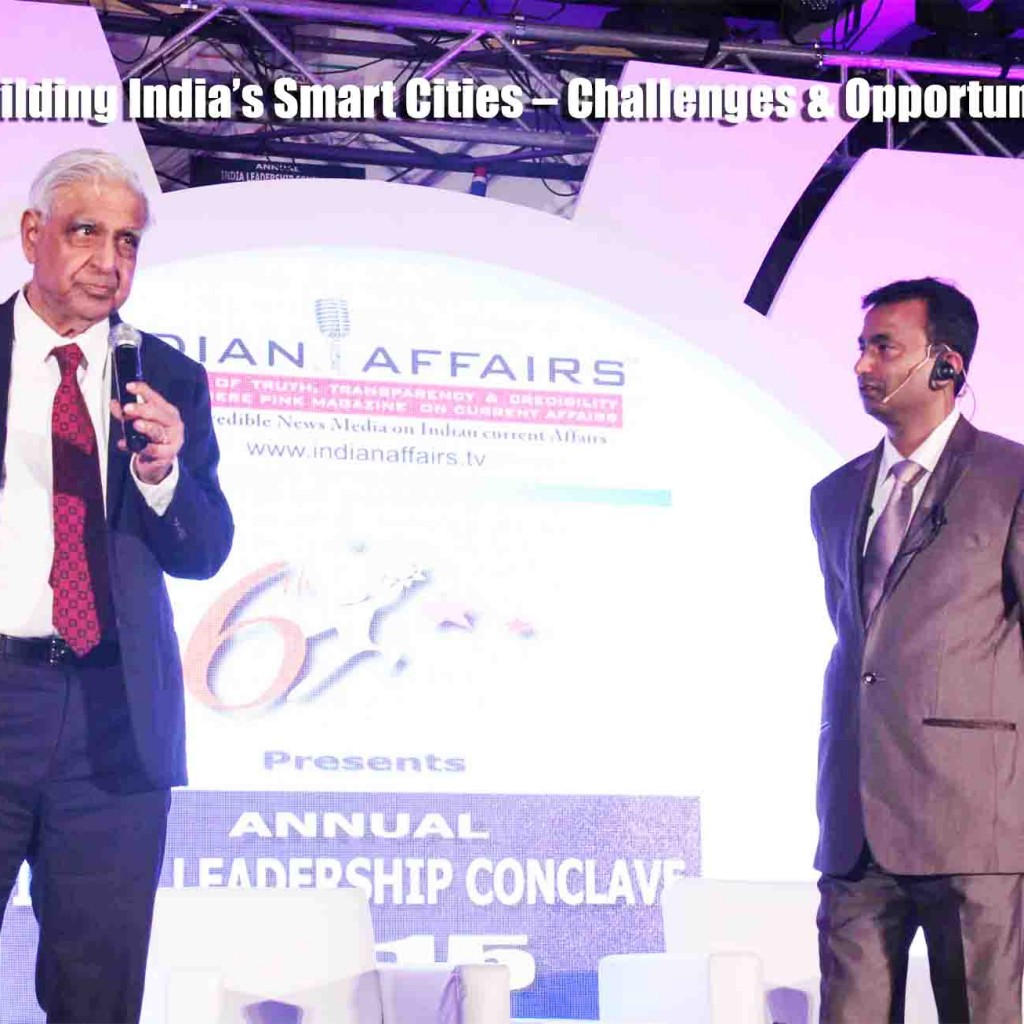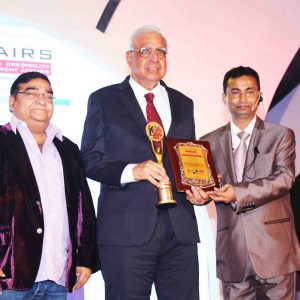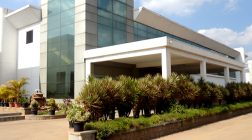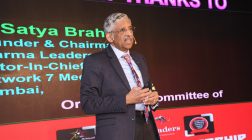Public-Private Partnership & Citizens Participation are key to the development of a successful Smart City Project In India – Datamatics Chief Dr. Lalit Surajmal Kanodia

Public-Private Partnership & Citizens Participation are key to the development of a successful Smart City Project In India. Building India’s Smart Cities – Challenges & Opportunities.
Here is the presentation of Dr. Lalit Surajmal Kanodia, Chairman of Datamatics Global Services Limited at the 6th Annual India Leadership Conclave & Indian Affairs Business Leadership Awards 2015 held recently in Mumbai on Friday,18th September 2015 at Hotel Sahara Star where more than 300 iconic Leaders attended at the 6th Annual India Leadership Conclave 2015. The Conclave witnessed the presence of top Business Leaders, Politicians, Social Activists, Women Leaders, Movie Stars & Rebel Leaders in a star-studded powerful gatherings at Hotel Sahara Star, Mumbai, India assembled to debate at title theme India @ 68. Other Speakers who addressed at India Leadership Conclave included are Mr.Jay Kumar Hariharan, CEO and Chief Coach –Blue Fire Coaching Consultants, Dr. C.R Parthasarathy, CMD, Sarathy Geotech & Engineering Pvt Ltd, Mr. Vivek Agrawal, Marketing Head, Giftxoxo.com, Dr. Mannan Gandhi, Dr. Mannan Gandh,Social Activist & Healing Consultant on Why India needs to come out the shackles of Religious extremism & Cultural Intolerance to give the World a Peace Message?, Dr. Debraj Shome Facial Plastic Surgeon, CEO & Co-Founder – MediAngels on Healthcare Delivery in India – Vision 2020, Mr. Gaurav Zutshi, CEO, My Mobile Payments Ltd on Unleashing Innovations in Mobile Payments, Mr. Jefre C Outlaw, Director, Global Relations, Gulf Coast,Renewables & Redevelopment LLC,( GCRR), Ms. Ajaita Shah Founder CEO, Frontier Markets on Empowering Women Through Social Entrepreneurship in Rural India, Dr Deepak Chaturvedi, Physician Endocrinologist & CEO – Amaya Clinic on Hormones & You. The panel discussion moderated by Satya Brahma, Editor-In-Chief of Network 7 Media Group raised the key concerns of evolving women in recent times on a topic Men and Women are equal-Choice brought Inequality participated by Ms. Ajaita Shah, Founder CEO, Frontier Markets, Ms. Archana Kochhar, Fashion Designer, Ms. Kiren Shrivastav, CEO, Molecule Communications. In another panel discussion on – India@68, Time to Click Selfie with India discussed in details the journey of India since independence included veterans such as 2. Mr. Kishore Mandyan, Former Deputy Director, Political, Peacekeeping and Humanitarian Affairs, Executive Office of the United Nations Secretary- General Mr. Aseem Trivedi, Cartoonist & Activist ,Mr. Mayank Gandhi, Member, National Executive, Aam Admi Party Ms. Nisha Jamvwal, Columnist, Brand Consultant
More than 35 Leaders & Companies were felicitated with top recognition at ILCX Power Brand 2015. The top recognition of Indian Affairs Indian of the year – IT ,Consulting & BPO Services went to Dr. Lalit Surajmal Kanodia, Chairman,Datamatics Global Services Limited
The glittering award ceremony saw the presence of Celebrities such as Govinda with wife Sunita Ahuja, Sanjay Khan, Zarine Khan, Ayesha Shroff who had gathered to see the award ceremony where Tina Ahuja, Govinda’s daughter was voted as Emerging Actress of the Year while Ayesha & Jackie Shroff’s son Tiger Shroff received the Promising Actor award at the 6th Annual India Leadership Conclave & Awards 2015. Farah Ali Khan received the prestigious Innovative Leadership in Luxury Brands Concept 2015 while South Actress & Mass queen Ragini Dwivedi received the Promising Actress Award.Satya Brahma, Chairman, India Leadership Conclave, Dr. Mukesh Batra, Chairman Dr. Batras & Bollywood Star Govinda conferred the awards in more than 35 categories.Commenting on the awards, Satya Brahma said “All the Award Winners at the 6th edition were screened in a detailed & meticulous methodology followed by a credible voting mechanism & a noted Jury Members. Our attempt is to recognize the shining stars & the leaders who are ignored due to the presence of the big players. Credibility in approach & transparency in selection process are key to the final winner added Satya.
Presentation of Building India’s Smart Cities – Challenges & Opportunities
I am delighted that our Prime Minister, Mr. Narendra Modi has taken the initiative to create 100 Smart Cities in India. I think this is an excellent move and in the strong long term interest of the country.There is no universal definition of a Smart City. Initially the word Smart City meant a city that deployed ICT i.e. Information & Communications Technology for the benefit of its citizens. Today it is much beyond that. One definition I like is that a Smart City is one that provides a good quality of life to its citizens. As cities improve, this bar will continue to be raised. India today has about 50 cities with a population of over 1 million. In contrast to China has over 300 such cities. We obviously need many more cities and we should plan for them to be Smart Cities. Since most of us are from Mumbai, I will use Mumbai to illustrate my examples. Worldwide as countries develop, their population migrates from rural to urban areas. In 1900 40% of the US population lived on farms. Currently in the US this is only 2%. China’s rural population today is 44%. By 2050 it is estimated that only 25% of the world population will live in rural areas. There is a strong economic reason why we need to urbanize. As all of you know, agriculture comprises only 15% of India’s GDP. About 68% of Indians live in villages and are primarily engaged in agriculture. There is virtually no manufacturing in villages though they do provide some services. At present about 30% of our urban population produces about 60% of our GDP. Hence, a person living in a city earns on an average twice what others earn. Interestingly enough 47% of Maharashtra lives in urban areas which is why it is one of the richest states of India. If this ratio between non-urban and urban areas continues, villagers will never increase their income. It is therefore in our national interest that we have polices to encourage migration from rural to urban. Though life in villages is romanticized, the reality is that they suffer from poor education, poor healthcare and poor infrastructure. The quality of their life will improve only if they migrate to cities.
The Random development of urban areas leads to chaos. The only recently well planned city was Chandigarh. Subsequently, an attempt was made to develop Navi Mumbai as a planned city but I am not sure we have succeeded. Smart Cities will need much better planning. Our Prime Minister has announced that the Centre will give Rs 48,000 crores over a period of 5 years for the development of 100 Smart Cities. The Centre will hence contribute Rs 100 crores per year, per city for 5 years. This is with a proviso that the State must match this figure. Therefore Rs 200 crores per smart city will be available every year for their development for 5 years. 10 cities in Maharashtra have been included in this list.
Our cities are bursting at their seams. Delhi, Mumbai and Kolkata are three of the largest cities in the world by population. Despite this the population in these cities continues to increase. This will definitely lead to a disaster. If you divide the population by area, Mumbai has a population of 21,000 persons / sq. km. which makes it one of the densest cities in the world. Unfortunately 54% of its citizens live in slums. Despite this we continue to increase the FSI of Mumbai. Singapore, in contrast, has a density of 7,300 persons per sq. km. Therefore, it is very important to provide an alternative to our existing metros. This is in the interest of one and all. As we know the price of apartments in South Mumbai is often over Rs 1 lac / sq. ft. Large buildings like Samudra Mahal are worth Rs 5,000 crores. While I am on this subject, I would like to talk about the Portlands. The Mumbai Port Trust owns 1740 acres of land on the eastern coast of the city of Mumbai. Most of this land is lying vacant since the ports have shifted to JNPT and virtually all industrial units there are closed. In fact, 10 lac tons of coal was dumped on its beaches every year and transported to Power Stations outside Mumbai. At any time about 1.5 lacs tons was lying on the beach. This resulted in serious health problems. Recently, the Press has reported that the Mumbai Port Trust has decided to stop this, which I hope they do. As all of you know when the textile mills left Mumbai about 600 acres were released. The proposal was that 66% would be used for the city and would have no construction on it. Finally only 20% went to the city, thanks to the collusion between politician and builders. The Mumbai Port Trust is willing to release about 900 acres of land of Portlands to the city of Mumbai. This is a God sent opportunity and I hope what happened to the mill lands will not happen to the Portlands. I would urge everyone to start a citizens movement to stop the abuse of public land and property by vested interests. Besides improving our quality of life, Smart cities will open up immense business opportunities for all of us. It will help the country, it will help businessmen, it will help every citizen. It is in our joint interest that we support this initiative of our Prime Minister.
Let me list some of the attributes of a Smart City. You will see that each one of them offers an immense opportunity to different sectors in our economic development and to all of you.
Traffic Lights
- To increase the throughput of our congested streets it is important to synchronize traffic lights on all main roads. For instance in New York city when you are travelling north to south, once you hit a green light, you should be able to hit a green light every time. These can double the capacity of our roads. If we instill sensors in traffic lights communicating by using blue tooth, the timing can be automatically altered, improving our traffic.
Smart Cars
- Smart driverless cars are around the corner. They are also called Google cars. It is estimated that they will reduce accidents by 75% Even at our low car density, 130,000 people die every year in India due to traffic accidents. Smart Cities should be planned for Smart Cars.
Law and Order
Maintenance of Law & Order is a national priority. Today cost of cameras and digital storage is plummeting. A grid of such cameras have a dramatic effect on crime.
Green Areas
Urban planning requires certain areas to be allocated as green areas which are the lungs of the city and provide playgrounds and recreation areas. London has 7 acres of open space per 1,000. Mumbai has 0.02 acres per 1,000 i.e. 1/350 of London ! Mumbai has grossly violated all norms. This is true for most other metros in India. Well planned cities will ensure this norm is complied with.
Pollution
- India and China are two of the most polluted countries. Pollution and carbon emissions cause illness, lowers life expectancy and lowers productivity. Recently we have starting measuring and reporting pollution. We have also started ranking cities on pollution. Delhi has twice the maximum acceptable limits of pollution. Mysore has the lowest pollution index. Green belts lower pollution. Smart Cities will ensure lower pollution.
Clean and Sufficient Water Supply
- Mumbai has a perpetual clean water problem. A smart city must provide for clean and perhaps drinkable water on tap. 52% of electricity consumption in Delhi is used for pumping water, due to faulty planning.
Smart Buildings
- Solar energy, use of LED lights, water harvesting, should be planned. Besides, better sewage disposal and garbage collection will help. India plans to generate 175 GW of Renewable energy by 2022. Of this 100 GW is planned to be solar, which includes 40 GW of roof top solar. Smart cities should plan for this.
Affordable Housing
- The cost of housing in India and particularly in the city of Mumbai is inordinately high. The cost of housing should be co-related to Per Capita Income. The proliferation of smart cities will automatically depress the price of our real estate for the benefit of our citizens and make housing affordable. In Singapore, 80% of the population lives in social housing. New York city is planning to build 200,000 affordable housing units over the next 10 years. China has 5.6 billion sq. m. under development i.e. about 40 sq. ft / person !
Cost of amenities such as plumbing, electrical fittings would be considerably reduced by higher volume and better planning.
Proximity of Housing & Workplaces
- Commuting is a waste of time and has a direct bearing on the GDP of a nation. In Mumbai most of us spend 2 hours or more every day in commuting, which is a colossal waste of time. A city must be planned in such a way that residences are proximate to workplaces. This reduces cars and public transport. It reduces fuel consumption. It reduces pollution. Smart cities must ensure this.
Safe Public Transportation
- Every citizen must have safe affordable transportation. Mumbai suburban trains are the largest public transport system in the world. However, there are about 10 deaths every day on Mumbai local trains. They are very unsafe for commuters too. Mumbai is planning for underground Metros. However, I wonder what will happen to these Metros when the city gets flooded during monsoons.
Power
- Mumbai is blessed. However, even cities like Bengaluru have 30% power cut. Smart Cities must plan to eliminate power outages.
Waterways
- Cities built on the ocean front and on rivers must develop waterways as they are the cheapest mode of transportation and also cause less pollution.
High Speed Wireless
- The bandwidth of wireless is increasing geometrically. In the West, 50 MBPS is common place. We need to install high speed lines in all our Smart Cities. Seoul is the most wired city in the world. We can learn from them.
City Apps
- A citizen should be able to find the closest store, the closest restaurant, the closest hospital, or the closest police station using a mobile App, when you use a Cell Phone. The above services can be of immense help and use to its citizens.
Education
- India still has 30% illiteracy. Myanmar has 7% and Sri Lanka has 9%. primary education, Vocational / Skill training and university education determine the well-being of any nation. In the USA, a school has to mandatorily admit a child staying in the “area”. Smart cities will provide well planned schools and colleges for its citizens.
Healthcare
- Healthcare is a great concern for all citizens. The USA spends 16% of its GDP on healthcare. India spends 4.5%. India has only one hospital bed per 1,000 citizen vs. 10 in the USA. Smart cities must provide adequate well planned hospitals and clinics.
911 Emergency Helpline
- In the US if you dial 911 a Central control room knows the exact location from where the call has originated and within 5 minutes you will find a police at your doorstep. It makes all emergency services including ambulance available to every citizen in the US. We need to do something similar in India.
Parking
- Many of us use drivers just because we cannot find parking. Parking in public roads is a norm. Smart cities would have planned parking.
Disaster Management
- Mumbai has witnessed havoc created by excessive rain and flooding. A Smart City would cater to Disaster Management.
Financing Smart Cities
- India today spends $17 / capita / on cities. Smart cities will need $130 / capita / year. This will need Government and Private Funding. We can do this via a Public Private partnership.
Smart City Administration
- Finally, a Smart City should be run by a person qualified in Urban Planning and not by an IAS officer.
LALIT SURAJMAL KANODIA*
Dr. Lalit Surajmal Kanodia is the Chairman of Datamatics Global Services Limited. He founded Datamatics Limited in 1975. He has a degree in Mechanical Engineering from IIT, Mumbai. Subsequently, he obtained an MBA and Ph.D., both from MIT, USA. He was a topper at MIT.Dr. Kanodia is the Founder CEO of TCS, which is today India’s most valuable company, with a Market Cap of over $80 billion.Dr. Kanodia is a Ford Foundation Fellow. He received the Distinguished Alumnus Award of IIT, Mumbai. He is one of the 10 persons included in the Hall of Fame, published by Dataquest alongwith our late Prime Minister Rajiv Gandhi and late Mr. JRD Tata. While in the US, he was Consultant to the Ford Motor Company and Arthur D. Little. He has also taught at Jamnalal Bajaj and MIT. He has served at the Past President of the Management Consultants’ Association of India and Chairman of the Electronic & Computer Software Export Promotion Council (Western Region). He is a member of the Executive Committee of the Indian Merchants’ Chamber and Chairman of its IT Committee. He is the past President of the Indo American Chamber of Commerce (Western Region). He has been a Member of the Executive Committee of Nasscom. He also served on various Committees of the Government of India and the State of Maharashtra. Dr. Kanodia is currently on the Executive Board of MIT (Europe, Asia and Africa).He was the Honorary Consul of Chile in Mumbai (2002-2014).











